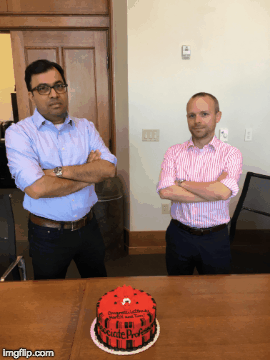Congratulations to Dr. Kartik Balachandran and Dr. Timothy Muldoon, who were each recently promoted to Associate Professor of Biomedical Engineering with tenure. Both Dr. Muldoon and Dr. Balachandran have been with the UArk Biomedical Engineering Department since its inception, and both are celebrated mentors, teachers, and researchers within the Department.
Dr. Balachandran’s Mechanobiology and Soft Materials Laboratory (MSML) investigates the role of mechanical forces on physiology, function and disease. In particular, Balachandran is interested in understanding the interaction between structure and mechanics in regulating biological responses at different length-scales. He and his lab team employ live cell imaging, cell/tissue mechanics, and tissue engineering techniques to focus on several cardiovascular bioengineering problems including cardiac valve calcification, valve fusion and blood-brain barrier dysfunction.
Recently, Dr. Balachandran also received a $154,000 Institutional Research Enhancement Award (AIREA) grant from the American Heart Association to fund a project that furthers his research on the human heart. The project, titled, “The Role of a Local Renin-Angiotensin System in the Initiation and Progression of Calcific Aortic Valve Disease,” aims to better identify mechanisms for the initiation and progression of calcific aortic valve disease (CAVD). Through benchtop research and animal studies, Balachandran and his team will be able to develop a potential therapeutic regime for the treatment or prevention of CAVD. The project will also support a full-time graduate student and two summer undergraduate students over the course of its duration.
During his time at the U of A, Balachandran has taught “Biomaterials,” as well as “Advanced Biomaterials and Biocompatibility,” and acted as mentor and advisor to numerous students. Doctoral student Nasya Sturdivant, one of Balachandran’s research advisees, said in a recent interview, “Working with Dr. Balachandran has been an amazing experience; he’s incredibly knowledgeable of a wide range of research subjects, he’s encouraging, and he pushes all of his students to their full potential.” Stated Alex Khang, a former researcher in Balahcandran’s lab and a recent NSF Graduate Research Fellowship recipient, “Dr. Balachandran was a fantastic mentor, and…he had a very large impact on my decision to pursue graduate school. Dr. Balachandran was very helpful during the NSF application process not only for me but for current and past lab members as well…Working in his lab was a tremendous experience. In the Mechanobiology and Soft Materials Laboratory (MSML), I learned a lot about how to conduct biomedical research and specifically a lot about nanofiber fabrication. Under Dr. Balachandran’s tutelage I got the chance to travel to national and international conferences to present our research and meet other members of the biomedical science community. Most importantly, I formed friendships in that lab that are irreplaceable.”
Dr. Muldoon’s research interests include multimodal microendoscopy, multiphoton imaging for gastrointestinal cancer, light sheet confocal microscopy, and whole blood analysis. He has authored 18 publications and over 35 conference papers to date, and has served as principal investigator on two National Institutes of Health research grants, including an Academic Research Enhancement Award (R15) from the National Cancer Institute for his work on developing multimodal endoscopic imaging and spectroscopy technologies. He was also recently awarded an Early Career Development award from the National Science Foundation to develop a novel method of three-dimensional imaging via an endoscopic catheter.
Among Dr. Muldoon’s advisees is doctoral student Gage Greening. In a 2016 interview, Greening said, “Dr. Timothy Muldoon is an excellent mentor. He allows me and his other graduate students to work on our own, make our own mistakes, develop as engineering, while at the same time being readily involved with our research…he [also] understands the fact that all his students have a diverse set of career goals and does his best to expose us to prominent members of our scientific community, whether that be through conferences, research collaborations, or publications.” Stated Courtney Hunter, one of Muldoon’s previous students and a former researcher in his Translational Biophotonics & Imaging Lab, “Working with Dr. Muldoon has been very rewarding. Everyone in the lab can tell he really cares about our individual success and the success of the group as a whole.” In his former role as Department Honors Coordinator, Muldoon also created the annual BMEG research symposium for undergraduates. Said Muldoon, “The Symposium was created to reflect the style of presentations that students, postdocs, and faculty encounter at professional scientific meetings. Students are required to distill their experiences and results down to a single poster and brief presentation to communicate what is often a complex, multi-year project.”
The classes Muldoon has taught at the U of A include “Introduction to Biomedical Engineering,” “Biomedical Instrumentation,” and “Biomedical Microscopy.” Last fall, he also taught “Cancer: A Constellation of Disease,” a University of Arkansas Honors College Signature Seminar that explored broad and complex issues that cut across science, medicine, industry and society, including: how do we allocate limited resources to combat cancer? Can we better treat patients as a whole person, rather than just their disease? Are we as a nation prioritizing the right things when it comes to treating an aging population?
Congratulations to Dr. Balachandran and Dr. Muldoon!


